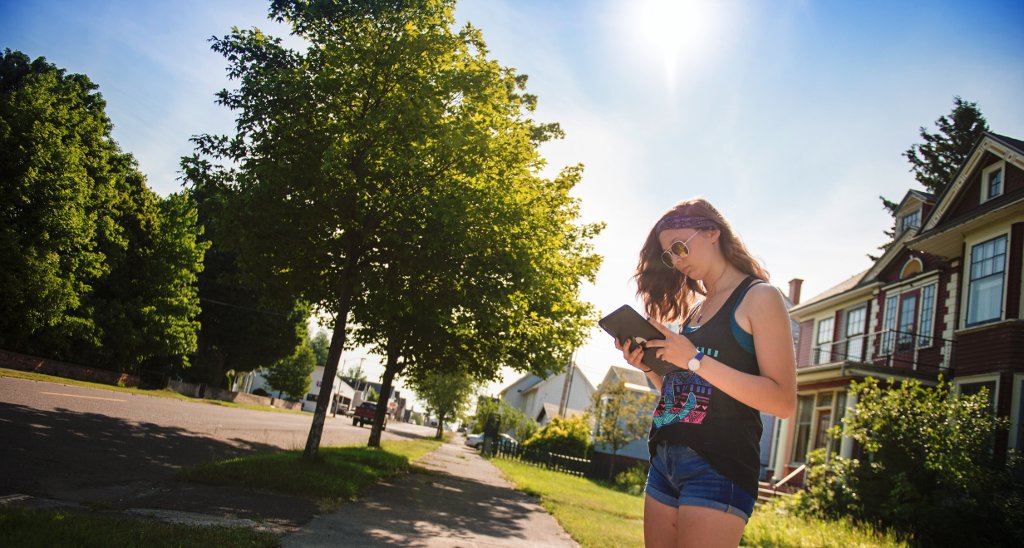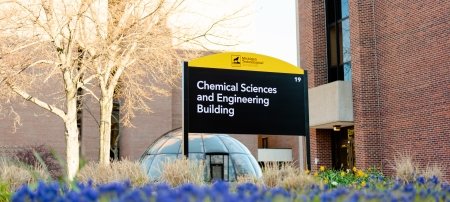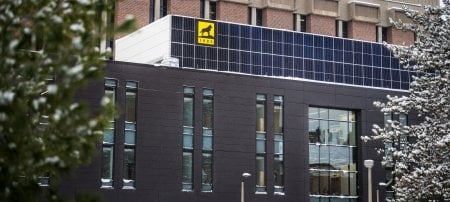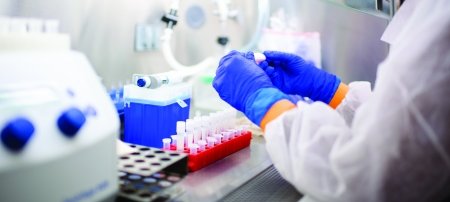GRACE project demonstrates the power of GIS to inform community and children’s health and well-being
It’s one thing to feel there are too few parks or crosswalks in a community, and another to back up that assertion with data.
This past summer, high school students participating in the GRACE project (GIS Resources and Applications for Career Education) explored area communities armed with GIS-enabled iPads to show where these places have infrastructure important for childhood health—or don’t.
Empowering Youth through Internships
The GRACE project trains high school teachers and students to use GIS (geographic information science) and spatial technologies to foster new ways to analyze community well-being. Michigan Tech researchers, partnered with colleagues at Eastern Michigan University and a number of other organizations, are equipping K-12 teachers and students to use GIS in multiple subject areas and empowering youth with marketable professional skills.

Youth-led Mapping to Improve the Health and Wellbeing of Children in Our Communities
This video explores the depth of the GRACE internship experience during summer 2017.
Statewide, the GRACE project is comprised of three levels. The explorer level introduces students to GIS applications and technologies. Next, the investigator level demonstrates data analysis capabilities and techniques. Finally, students participate at the internship level, on paid six-week internships with GIS professionals to work on real-world, community-based projects.
Michigan Tech implemented the internship component of the project in the summer of 2016, during which high school students participating in the GRACE program worked on the Keweenaw Time Traveler project.
“Students learned to create spatial data and learned about the impact of our industrial past on our present-day communities. They gained firsthand field-based knowledge about the impacts of the built environment on their lives,” says Don Lafreniere, assistant professor of geography and GIS.
In 2017, funded by a Michigan Tech Research Excellence Fund seed grant, GRACE students from Houghton and Calumet high schools mapped the villages of Calumet and Laurium to evaluate the quality of the built environments and their potential impacts on children’s health and well-being.
During the summer, students learned about mapping applications during visits to Hungarian Falls, the Quincy smelter, and the communities of Laurium and Calumet, and while exploring outcroppings of the Keweenaw Fault near Bete Grise and onboard the Michigan Tech research vessel Agassiz. Students learned how ground-penetrating radar and unmanned autonomous vehicles like drones are used to map cultural resources and shed light on potential environmental problems facing communities.

Leah Riutta, a junior at Calumet High School, says the experience opened her eyes to future career opportunities.
“I never realized you could use GIS in so many different jobs,” Riutta says. “I realized there’s a lot more fieldwork than I thought. Doing something with computers doesn’t necessarily mean you’ll be sitting at a computer all day.”
Participating in the GRACE project helped students like Riutta understand environmental factors that affect their communities and improve their confidence in their own ability to effect change.
“How safe do you feel walking down a street? How damaged are the sidewalks? You see cigarette butts or a place that sells alcohol and see people drinking alcohol. This affects youth and how they feel,” Riutta says. “I think [the GRACE project] makes people realize what’s being neglected and how we can change our town and make it a better place for the youth. I think the biggest problem would probably be the amount of vegetation. Adding some vegetation or beautification can make people feel safer and more welcome.”
Integrating Social Sciences and STEM
The GRACE project is linking social science research to STEM (science, technology, engineering and math) education to inform community health. Understanding how people interact with their neighborhood environments can improve decision making. Student-led, community-engaged projects like GRACE provide benefits to more people than just the youth who are directly participating.
GRACE begins by teaching students how the built environment impacts their health. In 2017, students learned to develop research questions that they wished to examine and determined the data they would need to answer their questions. Using mobile GIS technologies, they collected more than 125,000 observations in their own neighborhoods. Later in the summer, they returned to the laboratory and, with the help of Michigan Tech faculty and students, learned to use spatial analytical techniques to answer their research questions.
"We are using GIS as a STEM technology to help students invoke change in their communities. We’re giving them career skills in one of the biggest growing areas of jobs in the country, and giving them skills and readiness for post-secondary education, which is the goal of GRACE statewide."
National Attention
Charlie Fitzpatrick, K-12 education manager at ESRI, the company behind the ArcGIS software, traveled to the Keweenaw this summer to learn more about GRACE. “GIS is all about understanding the world in order to make good decisions and solve problems. With the GRACE project, students who get exposed get the opportunity to learn a bit more, develop skills, and turn those into longer-term opportunities that may influence how they go through college and early careers,” says Fitzpatrick.
Fitzpatrick noted that the three “ships” of education—scholarship, artisanship, citizenship—evolve into three Cs—college, career, and civic life. The GRACE program, he noted, is developing in students the necessary skills to help their communities.
"We want youth who can look at data, analyze, think critically, work with other people, know how to ask for help when they’re stuck, think independently, and explore and find information."
Tapping Local Resources
The success of the GRACE project to date is in large part due to its partnerships with the National Park Service and local planning organizations. The Keweenaw National Historical Park provided opportunities for the GRACE interns to apply their GIS skills to a project at the Quincy Mine office organized by Sarah Fayen Scarlett, assistant professor of history, using ground-penetrating radar to locate lost cultural features on the landscape, and to use drone-mounted photogrammetry to map underground workings at the Quincy smelter sites, organized by Tim Scarlett, associate professor of archaeology and anthropology. The Western Upper Peninsula Planning and Development Region provided professional guidance and support to the interns, including how to use GIS technologies to support creating park inventories for recreational master plans.
Teachers Houghton and Calumet high schools trained in the GRACE program have contributed to the depth of knowledge the students have about GIS and its many applications.
In the classroom, GIS skills aren’t limited to one subject. Mike Roland, who teaches career and technical education at Calumet-Laurium-Keweenaw School District, says that ArcGIS software can be used in science classes to teach the scientific method, in history classes to help students understand historical events, and in math classes to understand algebraic regressions.
“That’s what GRACE has brought to teachers—the opportunity to dig in and do the basic stuff. If the desire is there, every door is open to them to dig in deeper,” Roland says. “In the U.S., industry is screaming for people who have these types of skills.”
Next Steps
More than individual skills, GRACE empowers teachers and students to work with community members to contribute to meaningful decision-making in towns around the state.
Next summer, students will be placed in internships with local policy makers to map additional neighborhood-level drivers of health and well-being in youth. The intended outcome is that the students work with policy makers to contribute to decisions about park quality and quantity, crosswalk locations, street tree planting to encourage walking and biking, and promoting local access to healthy food in the form of community gardens.
It’s clear that GRACE participants are affected by what they learn. Three former interns have since enrolled at Michigan Tech in social sciences, computer engineering, and civil engineering. One of those students was the only freshman at Michigan Tech awarded a Portage Health Foundation Undergraduate Research Internship Award to continue GIS analysis on the relationship between the built and social environments and children’s health.
The researchers hope to extend the GRACE project to serve not only youth but also adult populations across the state in urban areas, like Flint and Detroit, and in rural communities, including other towns in the Upper Peninsula.
Michigan Technological University is an R1 public research university founded in 1885 in Houghton, and is home to nearly 7,500 students from more than 60 countries around the world. Consistently ranked among the best universities in the country for return on investment, Michigan's flagship technological university offers more than 185 undergraduate and graduate degree programs in science and technology, engineering, computing, forestry, business, health professions, humanities, mathematics, social sciences, and the arts. The rural campus is situated just miles from Lake Superior in Michigan's Upper Peninsula, offering year-round opportunities for outdoor adventure.






Comments